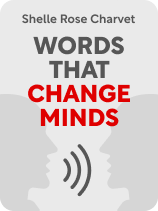

This article is an excerpt from the Shortform book guide to "Words That Change Minds" by Shelle Rose Charvet. Shortform has the world's best summaries and analyses of books you should be reading.
Like this article? Sign up for a free trial here.
Would you like to be more effective at convincing people to believe or do certain things? Are you a leader who struggles to get your team members on board?
In Words That Change Minds, communication and influencing language expert Shelle Rose Charvet identifies eight Productivity Patterns. She says that these patterns explain how an individual does their best work after they’ve decided to solve a problem.
Keep reading to learn several persuasive language techniques that take these Productivity Patterns into account.
Persuasive Language Techniques
According to Charvet, understanding Productivity Patterns is particularly important for managers who need to assign tasks to team members, as these patterns reveal individuals’ strengths and weaknesses in the workplace. To maximize productivity, assign team members tasks that require them to think as they’re naturally inclined to think.
(Shortform note: In First, Break All the Rules, Curt Coffman and Marcus Buckingham recommend strategically building teams in which each member’s strengths compensate for the others’ weaknesses. This way, teams can collectively accomplish tasks that a single employee can’t do on their own.)
Most Productivity Patterns lie on a spectrum between two opposites, and verbally mirroring someone’s pattern-driven language is one of the best ways to communicate with and influence them. Let’s take a look at the persuasive language techniques that Charvet recommends in the context of each of these patterns.
Pattern #1: Whole-Oriented or Detail-Oriented
The first Productivity Pattern we’ll discuss describes whether someone is more insightful when looking at the big picture or individual situations: Are they whole-oriented or detail-oriented? (Charvet calls this the “Scope” category.)
Whole-oriented people tend to speak in abstract, sometimes vague terms, writes Charvet. They might say, “We decided to move Brian to the sales team.” In contrast, detail-oriented people tend to describe concrete situations, sometimes in painstaking detail: “Last Friday, Trudy, Mark, and I met in Conference Room B and decided that Brian would be a better fit on the sales team because of how much he’s improved his people skills.”
Make sure to talk in terms of the big picture with whole-oriented people; otherwise, they’ll either get bored or feel overwhelmed. Likewise, speak in comprehensive, concrete terms with detail-oriented people, or they’ll become frustrated with your vague language.
Pattern #2: Level-Headed or Neurotic
The second Productivity Pattern is a description of how someone reacts to high-pressure situations: Are they level-headed or neurotic? Do they address intense events with cool, dispassionate logic, or do they frequently become emotionally overwhelmed? (Charvet calls this the “Stress Response” category.)
Charvet clarifies that unlike most of the other Productivity Patterns, this one isn’t revealed through the words someone says. You can gauge whether someone is level-headed or neurotic by paying attention to how outwardly emotional they are while speaking, especially when discussing a challenging situation. Level-headed people typically stay low-key and detached in conversation, while neurotic people visibly display emotions with their whole bodies—for instance, slumping their shoulders and collapsing into a chair when describing an exhausting day at work.
To influence level-headed people, take care to explain your point of view with airtight logic. To influence neurotic people, speak in emotional language that gets them excited to act.
Pattern #3: Team Player or Lone Wolf
The third Productivity Pattern refers to someone’s preferred level of interaction with other people: Are they a team player or a lone wolf? (Charvet calls this the “Style” category.) Team players do their best work in close collaboration with others—when they’re alone, they may struggle to focus and get things done. In contrast, lone wolves need their own space to do their best work and get distracted if other people are nearby.
To identify whether someone is a team player or a lone wolf, pay attention to how much they mention others when describing their tasks. Team players emphasize the actions of those around them: They might say “We launched our new ad campaign before the deadline we set for ourselves.” Lone wolves emphasize the actions and decisions they make as individuals: “I finished designing the full set of banner ads two months before launch day.”
If you’re managing a team, Charvet recommends that you make sure that team players have opportunities to collaborate with their coworkers while also making sure lone wolves have the personal time and space they need to do their work alone.
Pattern #4: Interpersonally Aware or Self-Preoccupied
The fourth Productivity Pattern describes someone’s sensitivity to nonverbal signals when interacting with others: They’re either interpersonally aware or self-preoccupied. (Charvet calls this the “Attention Direction” category.) People who are interpersonally aware are constantly monitoring the emotions and thoughts of those around them, while self-preoccupied people are only aware of their own emotions and thoughts.
Charvet contends that you can differentiate interpersonally aware and self-preoccupied people through their body language: Interpersonally aware people will display animated movements and facial expressions, whereas self-preoccupied people will generally display a flat affect.
Because your thoughts and emotions have such an impact on interpersonally aware people, send friendly nonverbal signals to make them more receptive to what you’re trying to say. On the other hand, self-preoccupied people typically won’t pick up on these signals.
Pattern #5: Empathetic or Analytic
The fifth Productivity Pattern we’ll discuss refers to how much someone believes emotions are a part of their work: Are they empathetic or analytic? (Charvet calls this the “Organization” category.) Empathetic people see all their tasks as primarily emotional endeavors—the whole point of the work they do is to positively impact someone emotionally (clients, co-workers, or anyone else they interact with). Analytic people, on the other hand, choose to focus on completing meaningful tasks without regard for how those around them feel.
Charvet explains that, when discussing their work, empathetic people will describe how it made them and those around them feel. Mirror this when communicating with them—you might praise an empathetic person by saying, “I loved your proposal to construct a new branch downtown, and the shareholders are going to love it, too.” On the other hand, when discussing their work, analytic people will simply describe the tasks they completed. You can appeal to them by similarly focusing on the work: “Your proposal is great. It’s very well-researched.”
| The Virtue of Reasoned Compassion In Against Empathy, Paul Bloom argues that the most effective and moral action is both analytic and empathetic—a “reasoned compassion.” If you solely perform analytic tasks without regard for their impact on others, you risk inadvertently hurting someone. However, Bloom argues that solely focusing on how people feel also causes undue harm. For one, empathy for those around you can cause you to cultivate anger against people who have done them wrong, fueling aggression and even violence. The solution, according to Bloom, is to use objective, analytical thought to solve problems and help other people. Rationally consider other people’s needs and emotions without fully immersing yourself in their emotional state and getting carried away by irrational feelings. To encourage the people in your life to practice reasoned compassion, consider talking them into a more balanced approach using the language of their motivation pattern. For example, you could say to an overly empathetic person, “When you get carried away, it sometimes frightens the people around you. Could you try to express your feelings in a more reasonable way?” Alternatively, you could say to an overly analytical person, “When you don’t think about how your work affects others, it often undermines the purpose of those tasks.” |
Pattern #6: Personal Standards
The sixth Productivity Pattern describes the behavioral standards someone expects themselves and others to meet. (Charvet calls this the “Rule Structure” category.)
According to Charvet, people can have one of four possible types of personal standards: objective, subjective, external, and egocentric. People with objective standards believe that certain behavior is objectively virtuous and desirable, judging everyone’s work (including their own) by the same criteria. In contrast, people with subjective standards believe that what’s good for one individual might not be good for another, and they tend to avoid judging or intervening in the behavior of others.
People with external standards need someone or something to tell them what behavior is appropriate or objectively good. They then apply these rules as objective standards for themselves and others. Finally, people with egocentric standards do whatever they believe is best and completely disregard the behavior of others. They also disregard whatever standards others have for them.
Charvet recommends discerning someone’s personal standards by directly asking them how they would ideally behave at work, then asking how someone else should ideally behave at work. To influence someone, appeal to their personal standards. For example, if someone has subjective standards, you might say, “Attending this leadership conference might not benefit everyone, but I think it would serve you well.”
Pattern #7: Persuasion Style
The seventh Productivity Pattern refers to the kind of evidence people need to encounter before changing their mind about something. We’ll call someone’s preference for one form of evidence their persuasion style. (Charvet calls this the “Convincer Channel” category.)
Charvet asserts that everybody has one of four persuasion styles: They find visual evidence, auditory evidence, written evidence, or experiential evidence the most persuasive. You can discern which persuasion style someone has by asking them how they came to a certain conclusion; for instance, you could ask how they determined that their current job was right for them. The evidence they used to reach their answer will correspond with one of the four persuasion styles.
To get someone to come to a certain conclusion after you’ve discerned their persuasion style, present them with their preferred form of evidence. For example, if you want to persuade someone that your restaurant is successful so they give you a loan for expansion, you can show them charts of your profits as visual evidence, practice a compelling business pitch as auditory evidence, show them customer reviews as written evidence, or let them taste your food as experiential evidence.
Pattern #8: Persuasion Requirements
The final Productivity Pattern also has to do with persuasion, describing how much evidence someone needs before they change their mind. We’ll call this baseline of evidence their persuasion requirements. (Charvet calls this the “Convincer Mode” category.)
According to Charvet, people have one of four kinds of persuasion requirements: If someone needs to see evidence a specific number of times before believing it, they have quantity-based requirements. If someone believes evidence only after a certain amount of time has passed, they have time-based requirements.
If someone believes everything after encountering just one piece of evidence—or no evidence—they have minimal requirements. If someone never fully believes anything, no matter how much evidence they see, they have strict requirements. (You can still persuade them to act a certain way, but they’ll never fully adopt your way of thinking. You’ll need to re-argue your point every time you want them to do something.)
You can identify someone’s persuasion requirements by posing a hypothetical situation and directly asking them how many times they would need to encounter evidence before coming to a conclusion about that situation. For instance, you could say, “If you were looking to partner with a marketing agency, how many times would you have to meet with them before making a deal?” Even if they don’t give an exact number, their answer will reveal their persuasion requirements.
To influence someone, fulfill their persuasion requirements—give them the amount of evidence or time they need to change their mind. For example, if the person giving your restaurant a loan has strict persuasion requirements, you can convince them to give you a loan by repeating the main points of your business pitch every time you meet with them.
Exercise: Practice Influential Communication
According to Charvet, knowing someone’s Productivity Patterns empowers you to influence their behavior. Practice this skill by preparing to influence someone you work with.
- Think of someone from work who’s frustrating you with something they do on a regular basis. Describe what they’re doing and what you’d like them to do instead. For example, perhaps your boss requires you to attend ineffective daily meetings. You’d rather they give you more time to work independently instead.
- Identify two or three Productivity Patterns you think that person has that are relevant to the given behavior. What have they done or said that makes you think they have those patterns? For example, you may recognize that your boss is reliable and a team player. You’ve never heard them question whether these meetings are necessary (reliable), and they frequently refer to the benefits of working together (team player).
- In a few sentences, write down what you might say to them if you were trying to influence them using language that mirrors the Productivity Patterns you’ve identified. For example, you might say to your boss, “To play my part on this team as effectively as possible (team player) and repeat last quarter’s successes (reliable), I need more time to work alone. Would you mind if I start skipping our daily meetings?”

———End of Preview———
Like what you just read? Read the rest of the world's best book summary and analysis of Shelle Rose Charvet's "Words That Change Minds" at Shortform.
Here's what you'll find in our full Words That Change Minds summary:
- Why it's sometimes hard to understand what others are trying to say
- The 14 kinds of mental habits that explain how people think
- How to understand others better and build positive relationships






